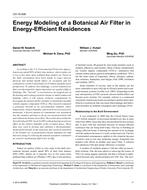This paper presents a determination of the expected concentrations for an actual building using the analytical and wind-tunnel modeling procedures presented in Chapter 14 of ASHRAE Fundamentals. A comparison of the estimated concentrations using the two methods is presented as well as a description of the calculation methodologies. The results of the comparison showed that for a low exit velocity stack with a small exit diameter and zero stack height, the wind tunnel and analytical estimates compare within a factor of two to six, with the ASHRAE estimates tending to be conservative. For a high exit velocity stack with a large diameter and zero stack height, the wind tunnel intake dilutions were generally an order of magnitude greater than those obtained using the analytical equations. The paper provides further evidence that the equations in Chapter 14 do provide conservative estimates of the expected dilution for laboratory stacks, even for the non-idealized building shape considered. However, the estimates may be overly conservative and may result in added design expense (unnecessarily tall stacks or emission control devices). If a designer wishes to optimize the stack design with respect to cost, aesthetics, and safety, the added accuracy provided by the wind hmnel may be necessary.
Citation: Symposium, ASHRAE Trans., vol. 95, pt. 2
Product Details
- Published:
- 1989
- Number of Pages:
- 8
- File Size:
- 1 file , 1.1 MB
- Product Code(s):
- D-27254


